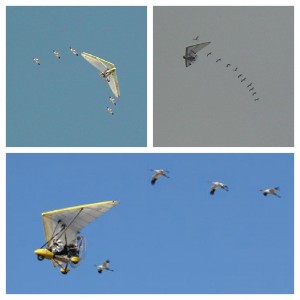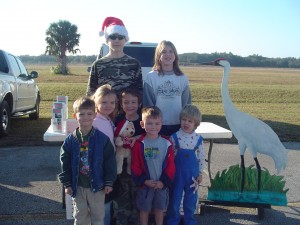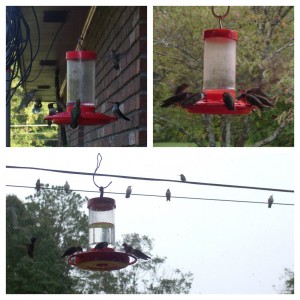
{This week’s Spotlight on the Crew article is brought to you from Wendy, at Life at Rossmont.}
Even the birds in the sky
know the right times to do things.
The storks, doves, swifts, and thrushes
know when it is time to migrate.
But my people don’t know
what the Lord wants them to do. Jeremiah 8:7, NCV
Birding has been an important part of my life since I was a young child, thanks to my mother. She took my brothers and me out birding, often. She even taught the children in her classrooms to enjoy birds, as well.
I’ve been doing my best to pass on the enjoyment to my children. It’s part of the “legacy” I wish to hand down to them. For one thing, we have several feeders, both seed feeders and hummingbird feeders, around our house. Most of them are out my bedroom window. It’s such a pleasure to watch the many kinds of feathered visitors.
One of the most fascinating aspects of birding is observing the migration seasons, both spring and autumn.
When we lived in Montana, we were near large, shallow lakes, which attracted many species of waterfowl: Snow Geese, Canada Geese, Swans, various ducks, teals and brants.
We eagerly awaited the birds in the spring, on their northward migration. We would see huge clouds of birds, and the air would be filled with their cries. Ah! The sounds of spring!
When we moved to Florida, I learned about Operation Migration, and Whooping Crane Eastern Partnership. Have you watched the movie, Fly Away Home? Well, Operation Migration uses ultra lights to lead whooping crane chicks from Wisconsin to Florida.
Each year they take eggs, laid by captive cranes, and hatch them in incubators. The project personnel follow strict protocols designed to prevent the chicks from imprinting on humans. To ensure the birds remain wild, handlers adhere to a no-talking rule and wear costumes designed to mask the human form while in the birds’ presence.
The chicks are then transported to Wisconsin in June to be conditioned to follow the ultralight aircraft. In this way, they are prepared for fall migration to wintering grounds in Florida. Every year since 2001, a class of cranes has been led on their first migration south from Wisconsin to Florida’s Gulf Coast.
Along the route South, there are locations where you can view the aircraft and Cranes flyover. The past couple years, they even have a webcam on one of the ultralights, which streams live to Ustream. They also stream the training sessions, etc. The web cam can also be viewed on the Operation Migration site.
One of the last flyover locations is the small airport in Dunnellon, Florida. Each year, large groups of “Craniacs” arrive, to watch the majestic birds fly overhead in silent awe. The children and I went several times while we lived there.
After the pilots circle overhead with the birds a few times, they lead them off to a pen site, then come back to the airport to meet the fans, and talk about the birds and their work with them.
Since we moved to Mississippi, I am now reduced to watching online. But I am very thankful we have that ability, thanks to the technology!
Our first autumn here in Mississippi, I learned about another spectacular migration: that of the Ruby-throated Hummingbirds. I will never forget how one early-autumn morning, I discovered half a dozen to a dozen hummingbirds at the feeder! Then it became nearly two dozen…then more! Not just around one feeder, but the rest of our feeders.
The feeding frenzy last several weeks; daily, dozens at a time at the feeders! We quickly learned how to prepare nectar (rather than buying that red stuff from the store!) by mixing 4 parts water, to 1 part sugar. We go through gallons of this nectar each season!
Now we start watching for them, anywhere from the end of August through mid September. They come a few at a time at first. Our resident hummers don’t like that! They are very territorial, and try to guard their feeders. But soon, the slow dance begins. More and more hummers arrive; it becomes harder for the resident sentinel to chase them off; while he’s chasing one away, two or three others land on the feeder.
Then one morning, we wake up to nearly a dozen at a time on the feeder. The sentinel gives up, or has flown further south himself.
I’ve heard there are hummingbird “festivals” in several locations. We have not been to any yet. You can find a list of festivals at Hummingbird-Guide (link: http://www.hummingbird-guide.com/hummingbird-festivals.html ).
I hope this will inspire you to incorporate bird watching, and migration tracking, in to your children’s lives. I’m sure you will all enjoy, and benefit, from the experience!
Useful links:
Journey North: Whooping Cranes
International Crane Foundation
Whooping Crane Eastern Partnership
Operation Migration Whooping Crane Cam
All About Birds, from The Cornell Lab of Ornithology
 Wendy is a veteran home schooling mom of 4 (ages 21, 19, 12, and 10). She and her family live on a small hobby farm in southwest Mississippi, where they enjoy caring for their goats, chickens, rabbits, dogs and cats, and watching birds at their feeders. When she has time, Wendy also enjoys reading, vegetarian cooking, scrap booking, card making, and sewing. You can find Wendy journaling her family’s journey on her blog, Life at Rossmont.
Wendy is a veteran home schooling mom of 4 (ages 21, 19, 12, and 10). She and her family live on a small hobby farm in southwest Mississippi, where they enjoy caring for their goats, chickens, rabbits, dogs and cats, and watching birds at their feeders. When she has time, Wendy also enjoys reading, vegetarian cooking, scrap booking, card making, and sewing. You can find Wendy journaling her family’s journey on her blog, Life at Rossmont.



1 thought on “Spotlight on the Crew — Nature Study: Migratory Birds”